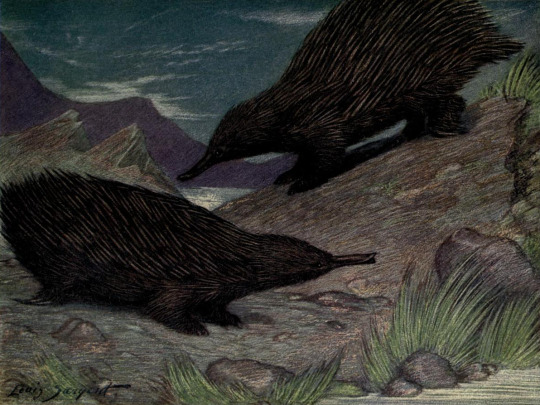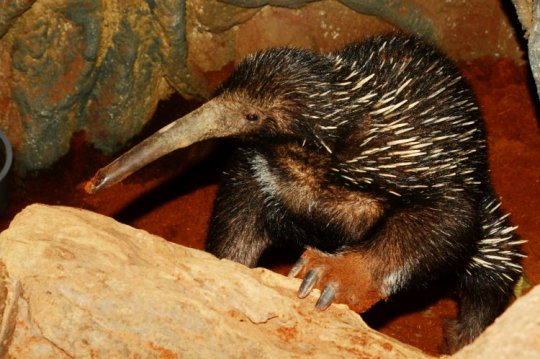#echidnas
Text

In more good news, the Sir David's long-beaked echidna, made an appearance on an expedition team's trail cams! This species hasn't been documented in over 60 years, and was thought to be extinct. This is also the first time a live specimen has been photographed/recorded, as the species was only identified in 1961 by a single dead specimen.
3K notes
·
View notes
Text

Echidnas by Louis A. Sargent. From Wild Beasts of the World, Vol. Two. Written by Frank Finn, published in 1909.
Internet Archive
398 notes
·
View notes
Text
Uncharismatic Fact of the Day
Blowing bubbles is a great summer pastime, especially for echidnas! Too keep themselves cool, short-beaked echidnas blow snot bubbles, and the mucus wets their snouts. When it the mucus evaporates the moisture draws out heat-- an efficient cooling method known as evaporative cooling.

(Image: A short-beaked echidna (Tachyglossus aculeatus) by Jamie Lamb)
373 notes
·
View notes
Text
Taxonomy Tournament: Mammals


Monotremata. The only order of mammals to lay eggs. It is made up of the duck-billed platypus and echidnas.
Chiroptera. This order is made up of bats, the only mammals capable of self-powered flight. It is the second-most speciose order of mammals, with over 1400 species.
#animals#biology#polls#poll tournament#zoology#platypi#echidnas#mammals#tetrapods#bats#Monotremata#Chiroptera#0x0v0x7f
157 notes
·
View notes
Text
Wonderful news from the Cyclops Mountains of West Papua today with the rediscovery of Attenborough's long-beaked echidna (Zaglossus attenboroughi)!

(Image credit: Expedition Cyclops)
Previously known a single specimen collected in 1961, Attenborough's long-beaked echidna has long been one of the world's most elusive mammals. Recognised as a distinct species in 1998, an expedition to the Cyclops Mountains in 2007 failed to observe the echidna but found evidence of recent diggings and foraging activity which, alongside local knowledge, implied that the species still survived in those remote mountain forests.
Finally, just a few months ago, a new expedition into its remote mountain home by Expedition Cyclops caught the first ever footage of Attenborough's long-beaked echidna in the wild, which is also the first time it has been seen by scientists in over 60 years. In a remarkable stroke of luck, the echidna was captured on the last of over 80 camera traps on the final day of the trip!
Attenborough's long-beaked echidna is the most distinctive of the three species of long-beaked echidna thanks to its smaller size, shorter, straighter beak and reddish-brown fur. Its habits are virtually unknown, but its differently shaped beak may suggest that it differs in diet and feeding habits from the other two long-beaked echidna species. It appears to be endemic to the highest elevations of the Cyclops Mountains, which are steep, extremely rainy and treacherous to explore, hence why it remained hidden for so long.

(Image credit: Expedition Cyclops)
There are only five species of monotreme alive today, the sole living custodians of a lineage stretching back some 200 million years, and this makes each species extraordinarily valuable. Unfortunately, all three species of long-beaked echidna are threatened with extinction, with Attenborough's long-beaked echidna being classed as critically endangered. Losing any species is a tragedy, but for a group as small and precious as monotremes, any extinction would be especially disastrous.
Alongside the rediscovery of the echidna, Expedition Cyclops also made the first record of Mayr's honeyeater (Ptiloprora mayri) in 16 years and discovered dozens of new species of insects, arachnids, shrimp and frogs. Their work documenting the hidden biodiversity of the Cyclops Mountains is ongoing, so if you'd like to follow and support the expedition make sure to visit their website!
https://www.expeditioncyclops.org/
#oceania#papua#west papua#new guinea#wildlife#mammal#mammals#monotreme#monotremes#echidna#echidnas#animal facts#animal news#mammalogy#natural history#my stuff
288 notes
·
View notes
Text

A Western long beaked echinda (Zaglossus bruijnii) in Batu Secret Zoo, Java, Indonesia
by Johannes Pfleiderer
#western long beaked echidna#long beaked echidnas#echidnas#monotremes#zaglossus bruijnii#zaglossus#tachyglossidae#monotremata#mammalia#chordata#captive animal#batu secret zoo
245 notes
·
View notes
Photo

The wild beasts of the world - 1909 - via Internet Archive
626 notes
·
View notes
Text

Short-beaked echidna! The four species of echidna and the platypus are the world’s only egg-laying mammals! Echidnas are monotremes, meaning they both lay eggs and nurse their young. Echidna babies are called puggles, and are nursed in a pouch until they start developing their spines at around 50 days old.
[ID: an illustration of an echidna facing toward the viewer, with termite mounds in the background. End.]
268 notes
·
View notes
Text

✨The sisters✨
For @adeleanis and @gazpacho-lover
#myart#my art#digital art#Sonic#sonic the hedgehog#sonic oc#echidnas#echidna#sth#Gift#Friends#Sisters#Team
64 notes
·
View notes
Text

reblog if you support the humble echidna
#LISTEN#echidna#are adorable and weird and perfect#australia#wake up to your awesome lil pincushion#monotreme#marsupials#platypus#animals#animal awareness#rare animals#exotic animals#endangered animals#spreading the echidna propaganda#echidnas#mammals#mammalia#zoology
101 notes
·
View notes
Text
looking at..... puggles.....




pls observe
209 notes
·
View notes
Text

Animal Ghosts. Edited by Claudia Clow. Illustrated by Walt Disney Productions. 1971.
Internet Archive
330 notes
·
View notes
Text
Uncharismatic Fact of the Day
Echidnas might appear spiky, but their signature look actually just a unique hairdo! Each spine is a thick, hollow hair follicle reinforced with keratin- the same protein that makes up claws, horns, and fur. In addition to this prickly defense mechanism, echidnas also have a layer of shorter fur that keeps them warm.

(Image: A short-beaked echidna (Tachyglossus aculeatus) by Tamara Montgomery)
If you like what I do, consider leaving a tip or buying me a ko-fi!
307 notes
·
View notes
Text
Taxonomy Tournament: Mammals


Scandentia. This order is made up of treeshrews, small mammals native to South and Southeast Asia. They are sometimes used as model organisms due to being closely related to primates.
Monotremata. The only order of mammals to lay eggs. It is made up of the duck-billed platypus and echidnas.
#okay it's kinda funny that the gimmick of this bracket is that#matchups are usually between animals that are closely related#but the very first match involves two animals who are as unrelated as any two mammals can be#but y'know; that's really the only way to fit monotremes in the bracket#still its ironic that our first match is an exception to the rule#animals#biology#polls#poll tournament#zoology#treeshrews#mammals#tetrapods#platypi#echidnas#Scandentia#Monotremata#0x0v0xff#Animal Tournament#Animal Tournament Round 1
61 notes
·
View notes
Text

man what the hell .
40 notes
·
View notes
Text

A shy beast.
I didn't really understand echidnas until I looked at them properly, in person. They are so charming. And so silly. I'm obsessed with them now.
Taken in Dryandra Woodland, 9/4/23
Canon R7
Canon EF 100-400 L IS USM
#echidnas#wildlife#monotremes#mammals#australianwildlife#australia#wildlifephotography#beasts#echidna#dryandra#dryandra woodland
61 notes
·
View notes